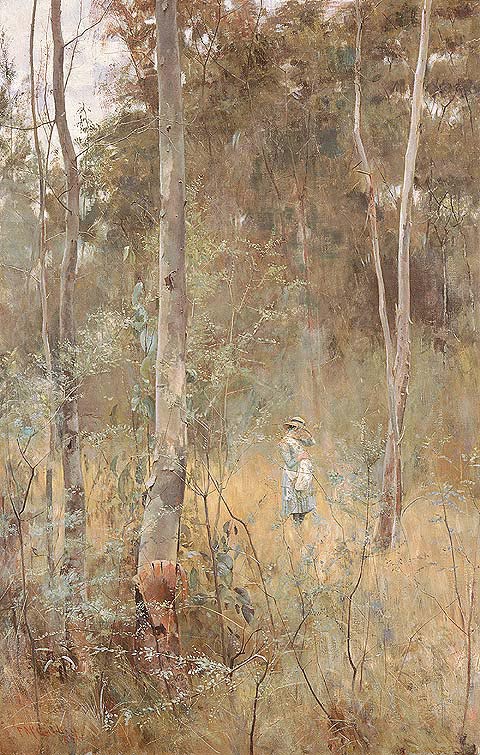
In the almost trackless wilds of the Lilydale district, intersected by reedy ferns, like an Indian swamp, Clara Crosbie, a girl of 12, was lost nearly a month ago … A town-bred girl of warm affections and quick impulses, she pined in the unaccustomed solitudes of the bush, and she resolved to find her way, though she did not know her way home. The Argus Newspaper. Melbourne, 1885.
Inspired by the true story of Clara Crosbie, Frederick McCubin painted The Lost Child in 1886. In the painting McCubin contrasts the innocence of Clara with the rugged Australian trees which threaten to entrap her. The painting is representative of the early colonial fear which viewed Australia as a place where people disappeared. In the nineteenth century this was a popular theme in literature, particularly in the works of Marcus Clarke, Joseph Furphy, and Henry Lawson. The long distance of Australia from Britain provoked intense feelings of anxiety and was an important part of the colonial experience. Australia was regarded as a country on the edge of the earth and was literally a land where undesirable civilians from Britain were sent to disappear.
This composition overturns the narrative of fear, imagining Clara Crosbie as she briefly becomes entranced by the sounds of the bush. The soft calls of bellbirds and crickets emerge from the trees, providing respite from her predicament. There is a moment of transcendence as Clara finds pleasure in her surroundings, yet home is still far away.
really enjoyed that, thanks!
LikeLike
Good to know, thanks. More are on the way.
LikeLike
I love this piece. The sound of the bellbirds reminds me of a walk I had family in the Blue Mountains, Katoomba, a couple of weeks ago.
LikeLike
Thanks Warren. Bellbirds do have a magical quality to them, don’t they? I’d love to have a house surrounded by them.
LikeLike
Just wanted to say a big thank you for this! I’m using this painting in an assignment for Uni and what you captured is perfect; with the exception of the Bell Bird(s), it sounded exactly like my backyard when I was a kid. I am curious though… what made you choose the painting?
LikeLike
Thanks for the feedback. It’s a while since I did this one but at the time I was really interested in the idea of the Australian Gothic and I felt like it fit the narrative of this genre quite well.
LikeLike